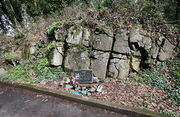Steve Prefontaine
| Steve Roland Prefontaine | |
|---|---|
| Born | Steve Roland Prefontaine January 25, 1951 Coos Bay, Oregon, United States |
| Died | May 30, 1975 (aged 24) Eugene, Oregon |
| Cause of death | Car Accident |
| Residence | Eugene, Oregon |
| Other names | "Pre", "World", "Rube" |
| Known for | long-distance runner, Track and Field runner |
| Website | |
| www.prefontainerun.com | |
| Medal record | ||
|---|---|---|
| Men's athletics | ||
| Pan American Games | ||
| Gold | 1971 Cali | 5000 m |
Steve Roland "Pre" Prefontaine (b. January 25, 1951 Coos Bay, Oregon – May 30, 1975) was an American middle and long-distance runner. Prefontaine was primarily a long-distance runner, who once held the American record in the seven distance track events from the 2,000 meters to the 10,000 meters.[1] Prefontaine died at the age of 24 in a car accident.
Prefontaine helped inspire the "running boom" in the 1970s along with contemporaries Frank Shorter and Bill Rodgers.
Contents |
Marshfield High School (1966–1970)
Prefontaine's parents, Raymond and Elfriede Prefontaine, were of French-Canadian and German descent, respectively. He was often known for his mustache and his long locks of hair that parted as he ran. As a freshman at Marshfield High School in Coos Bay, Oregon, Prefontaine found some success in cross country. With help from the Marshfield cross country coach, Walt McClure, he placed 53rd in the Oregon state meet. During his freshman year, Prefontaine established relatively modest personal bests of 5:01 in the mile and 10:08 in the two-mile. Determined to improve, Prefontaine undertook a high-mileage training plan during the summer, and placed sixth in the year-end state meet.
His sophomore season was unspectacular, with the exception of the district cross country meet, where Prefontaine stayed close with the state mile and cross country champions. He continued rigorous training at the end of the cross country season in preparation for track, following up with a 4:31 indoor mile, but his fourth-place finish in that spring's district track meet failed to qualify him for the high school state meet in his primary event, the two-mile. He then met coach and mentor Bernard Emil Weik II who taught him several breathing techniques which shaved 3 seconds off of his previous records.
Prefontaine's junior and senior years proved highly successful. He won every meet, including the Oregon state championship, and set a national high school record his senior year in the two-mile race with a time of 8:41.5 (improving on Rick Riley's 8:48.3 from 1966). That record would stand for four years, until Craig Virgin bested it by half a second; Virgin said he was unimpressed that he broke the national record by only a half-second, whereas Prefontaine surpassed the old one by 6.9.[2]
The Pete Susick Stadium at Marshfield High School dedicated their track to honor Prefontaine in April, 2001.[3]
University of Oregon (1970–1973)
Prefontaine was recruited by several top track programs across the United States, but decided to enroll at the University of Oregon to train under coach Bill Bowerman (who in 1964 founded Blue Ribbon Sports, later known as Nike shoe company). After his freshman year, in which he finished third in the NCAA Men's Cross Country Championships, he suffered only two more defeats in college (both in the mile), winning three Division I NCAA Cross Country Championships and four straight three-mile/5000-meter titles in track. He was a member of the Pi Kappa Alpha fraternity.
Prefontaine was an aggressive runner, insisting on going out hard and not relinquishing leads. He was quoted as saying, "No one will ever win a 5,000 meter by running an easy two miles. Not against me". He would later state, "I am going to work so that it's a pure guts race. In the end, if it is, I'm the only one that can win it". A local celebrity, chants of "Pre! Pre! Pre!" became a frequent feature at Hayward Field, a mecca for track and field in the USA. Fans wore t-shirts that read "LEGEND", while those who supported other teams wore shirts with the phrase "STOP PRE" printed on a stop sign. Prefontaine gained national attention and appeared on the cover of Sports Illustrated at age 19.
Prefontaine set the American record in the 5000 meters race, the event that took him to the 1972 Summer Olympic Games in Munich. In the finals, Prefontaine took the lead in the last mile and ended the slow pace of the first two miles. He held the lead until the last 150 meters before battling for first against Lasse Virén and silver medalist Mohammed Gammoudi. Britain's hard-charging Ian Stewart moved into third place in within ten meters of the finish line to deprive Prefontaine of a medal.
Returning for his senior year at the University of Oregon, Prefontaine ended his collegiate career with only three defeats in Eugene, all in the mile. It was during this year that Prefontaine began a protracted fight with the Amateur Athletic Union (AAU), which demanded that athletes who wanted to remain "amateur" for the Olympics not be paid for appearances in track meets. Some viewed this arrangement as unfair, because the participants drew large crowds that generated millions of dollars in revenue, with the athletes being forced to shoulder the burden of all their own expenses without assistance. At the time, the AAU was rescinding athletes' amateur status if they were endorsed in any way. Because Prefontaine was accepting free clothes and footwear from Nike, he was subject to the AAU's ruling.
Post-collegiate (1974–1975)
Following his collegiate career at Oregon, Prefontaine prepared for the 1976 Summer Olympics in Montreal. While running for the Oregon Track Club, Pre was setting American records in every race from 2000 to 10000 meters.[2]
Death
On May 30, 1975, returning from a party and after dropping off friend and distance champion Frank Shorter, Prefontaine was driving down Skyline Boulevard, east of the University of Oregon campus near Hendricks Park, when his orange 1973 MGB convertible swerved to the left and hit a rock wall along the side of the street. The overturned car trapped Prefontaine underneath it. The first witness on the scene, who lived nearby, ran outside and found Prefontaine flat on his back, still alive but pinned beneath the wreck. After attempting to lift the vehicle, the bystander ran to get help. By the time he returned with others, the weight of the car had crushed Prefontaine's chest, killing him.
Prefontaine is buried at Sunset Memorial Park in Coos Bay.
Aftermath
The Eugene Register-Guard called his death "the end of an era". By the time of his death, Prefontaine was a popular athlete who, along with Frank Shorter and Bill Bowerman, was credited with sparking the running boom of the 1970s. His life story has been detailed in two dramatic films, 1997's Prefontaine and 1998's Without Limits, as well as the documentary "Fire on the Track". An annual track event, the Pre Classic, has been held in his honor since 1975.
Over his career, he won 120 of the 153 races he ran (78 percent). Prefontaine liked to say, "To give anything less than your best is to sacrifice the Gift."
Memorials

Pre's Rock is a memorial at the site of the roadside boulder where Prefontaine died. Many runners inspired by Prefontaine leave behind memorabilia to honor his memory and continued influence, such as race numbers, medals, and running shoes. Pre's Rock was dedicated in December 1997 and is maintained by Eugene Parks and Recreation as Prefontaine Memorial Park.[4] The rock is just across the Willamette River from the east end of Pre's Trail. The memorial features a plaque with a picture of Prefontaine that reads:
| “ | For your dedication and loyalty To your principles and beliefs... For your love, warmth, and friendship For your family and friends... You are missed by so many And you will never be forgotten... |
” |
The Prefontaine Memorial, featuring a relief of his face, records, and date of birth, is located at the Coos Bay Visitor Center in Coos Bay. In 2008, ten memorial plaques were laid along the Prefontaine Memorial Race route, the former training grounds of Prefontaine. The plaques bear an image of Prefontaine from his high school year book and various quotes and records from his time in Coos Bay. The plaques were part of a grant from the Oregon Tourism Commission, the Coos Bay-North Bend Visitor & Convention Bureau, and the Prefontaine Memorial Committee.
Each year on the third Saturday of September in Coos Bay, over 1000 runners engage in the Prefontaine Memorial Run, a 10k run honoring his accomplishments.[5]
The Coos Art Museum in Coos Bay contains a section dedicated to Prefontaine. This section includes medals he won during his career and the pair of spikes he wore when setting an American record for the 5,000 meters at Hayward Field.
In 1983, Prefontaine was inducted into the Oregon Sports Hall of Fame, where several exhibits showcase his shoes, shirts, and other memorabilia. Nike used video footage in a commercial titled "Pre Lives", advertising his spirit for their product. On the 30th anniversary of his death, Nike placed a memorial in Sports Illustrated, and aired a television commercial in his honor.
Nike's headquarters have a building named after him.
See also
- Pre's Trail
- Prefontaine (1997 film)
- Without Limits (1998 film)
Steve Prefontaine is an inductee of The National Track and Field Hall of Fame in upper Manhattan where one of his Oregon University track uniforms is on display.
References
- ↑ "Steve Prefontaine". National Distance Running Hall of Fame. http://www.distancerunning.com/inductees/2000/pre.html. Retrieved 2007-02-19.
- ↑ 2.0 2.1 "Steve Prefontaine Bio & Pix". University of Oregon, Official Athletic Site. http://www.goducks.com/ViewArticle.dbml?DB_OEM_ID=500&ATCLID=30594&SPID=243&SPSID=4584. Retrieved 2007-02-19.
- ↑ The Steve Prefontaine Track
- ↑ "Prefontaine Memorial Park". City of Eugene. http://www.eugene-or.gov/portal/server.pt?open=512&objID=677&PageID=1651&cached=true&mode=2&userID=2. Retrieved 2208-03-18.
- ↑ Prefontaine Run
External links
- Prefontaine at the Internet Movie Database
- Steve Prefontaine at Find a Grave
- Without Limits at the Internet Movie Database
- Without Limits -vs- Prefontaine at Movie Smackdown
- Official website
- Prefontaine Classic homepage
- Guide to the Bill Bowerman Papers at the University of Oregon
- Steve Prefontaine Bio & Pix - University of Oregon, Official Athletic Site
- Nike Commercial "Pre Lives"
- Running Legends, Steve Prefontaine
- Prefontaine Dedication
- Born to Run, From a Kid in Coos Bay to an Unbelievable Legend
- "Without Limits" Trailer
- Nike 30th Memorial Commercial
- Original 1972 Olympic 5k, Steve Prefontaine
- Original 1972 Olympic 5k-2, Steve Prefontaine
|
||||||||||||||||||||
|
|||||
|
|||||
